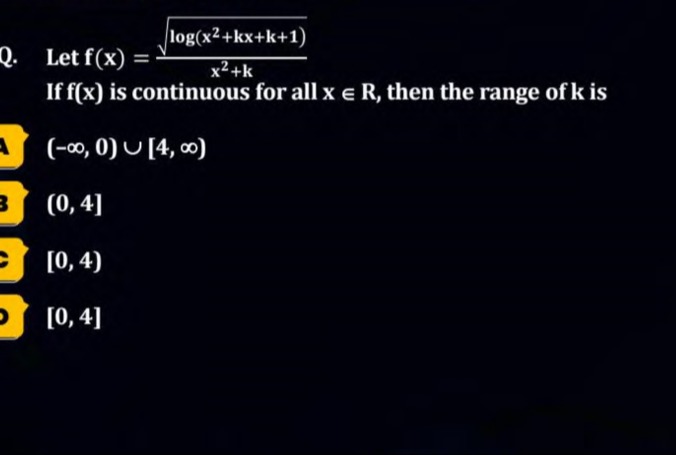Question
Question: Let $f(x) = \sqrt{\frac{\log(x^2+kx+k+1)}{x^2+k}}$. If $f(x)$ is continuous for all $x \in \mathbb{R...
Let f(x)=x2+klog(x2+kx+k+1). If f(x) is continuous for all x∈R, then the range of k is

(−∞,0)∪[4,∞)
[0,4]
[0,4]
[0, 4]
[0,4]
Solution
For the function f(x)=x2+klog(x2+kx+k+1) to be continuous for all x∈R, its domain must be R. This requires two main conditions:
-
The argument of the logarithm must be positive for all x∈R: x2+kx+k+1>0. This is a quadratic in x with a positive leading coefficient. For it to be always positive, its discriminant must be negative. Δ1=k2−4(1)(k+1)<0 k2−4k−4<0. The roots of k2−4k−4=0 are k=24±16−4(1)(−4)=24±32=2±22. Thus, for the inequality to hold, 2−22<k<2+22.
-
The expression under the square root must be non-negative for all x∈R: x2+klog(x2+kx+k+1)≥0.
We analyze this based on the denominator x2+k:
-
Case 1: k>0. In this case, x2+k>0 for all x∈R (since x2≥0). The condition simplifies to log(x2+kx+k+1)≥0. Since the base of the logarithm is e (or any base >1), this implies x2+kx+k+1≥e0=1. x2+kx+k≥0. For this quadratic to be always non-negative, its discriminant must be less than or equal to zero. Δ2=k2−4(1)(k)≤0 k(k−4)≤0. This inequality holds for 0≤k≤4. Combining with the condition k>0, we get 0<k≤4.
-
Case 2: k=0. The function becomes f(x)=x2log(x2+1). The denominator x2 is zero at x=0. For continuity, we check the limit as x→0: limx→0x2log(x2+1). Using L'Hôpital's rule or the standard limit limy→0ylog(1+y)=1, we get the limit as 1. So, limx→0f(x)=1=1. The function can be defined as f(0)=1 to be continuous. For x=0, x2>0 and x2+1>1, so log(x2+1)>0. Thus, x2log(x2+1)>0. The condition x2+klog(x2+kx+k+1)≥0 is satisfied for k=0.
-
Case 3: k<0. If k<0, then for x=0, the denominator x2+k=k, which is negative. This means the denominator can be negative, leading to potential issues with the expression under the square root. For the function to be defined for all x, the denominator x2+k must not be zero for any x. This implies x2=−k must have no real solutions, which means −k<0, or k>0. Thus, k<0 is not allowed for the denominator to be consistently positive or non-negative in a way that allows continuity for all x.
Combining the valid cases for the second condition, we have k=0 or 0<k≤4, which gives 0≤k≤4.
Finally, we intersect the ranges from both conditions: (2−22,2+22)∩[0,4]. Since 2−22≈−0.828 and 2+22≈4.828, the interval [0,4] is fully contained within (2−22,2+22). Therefore, the intersection is [0,4].
-
